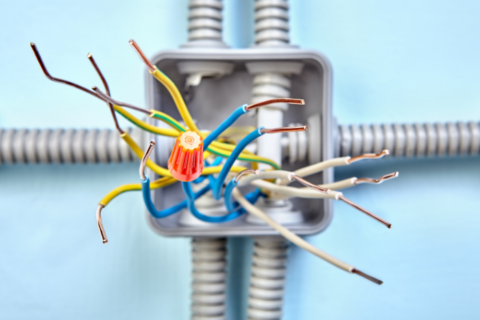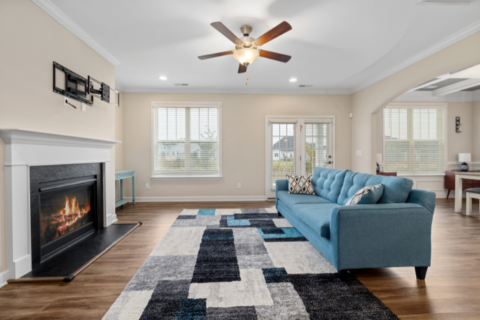Installing Motion Sensor Light – a Guide for Homeowners in Rhode Island
Installing Motion Sensor Light
As a homeowner in East Providence, Rhode Island, you know that keeping your home safe and secure is a top priority. It can be overwhelming to constantly worry about the security of your home, especially with the busy schedules many of us have. Fortunately, advancements in technology have made it easier than ever to keep your home safe and secure. One such advancement is motion sensor lights.
At B&K Electric, a family-owned and operated electrical business based in Warwick, RI, we understand the importance of safety and security in your home. With over seventeen years of experience in providing electrical repair, panel maintenance, and installation services in areas like Cranston, Warwick, and all of Rhode Island, we have become the go-to electrician for many homeowners in the greater Providence Area. In this article, we will guide you on how to install motion sensor lights in your home, to add an extra layer of security and peace of mind.
Benefits of Motion Sensor Lights
Before diving into the installation process, it is essential to understand the benefits of motion sensor lights and why they are a valuable addition to your home. Motion sensor lights are designed to automatically turn on when they detect movement, and they can be used both indoors and outdoors. Here are some reasons why installing motion sensor lights is a good idea for homeowners in Rhode Island.
1. Enhanced Security
One of the primary reasons for installing motion sensor lights is to enhance the security of your home. By illuminating the exterior of your home when motion is detected, these lights can deter potential intruders and make your home less of a target. Additionally, they can also help you identify suspicious activity around your home, keeping your family and property safe.
2. Convenience
Motion sensor lights provide a hands-free option for illuminating your home. This means that you no longer have to fumble with light switches or risk walking into a dark room. Whether you are arriving home late at night or carrying groceries to your doorstep, the lights will automatically turn on, providing sufficient illumination.
3. Energy-Efficiency
Motion sensor lights are also energy-efficient, as they only turn on when motion is detected. This means they are not constantly on like traditional lights, hence reducing your energy bill. Additionally, they come with different settings that allow you to adjust the sensitivity and duration of the lights, making them even more energy-efficient.
Installation Process
Now that you understand the benefits of motion sensor lights, let’s dive into the installation process. Keep in mind that it is always recommended to hire a licensed electrician for this type of installation to ensure safety and proper functioning of the lights. However, if you fancy doing it yourself, here is a step-by-step guide on how to install motion sensor lights in your home.
Step 1: Choose the Right Lights
Before anything else, you need to choose the right motion sensor lights for your home. Take into consideration the area you want to install the lights, the type of sensor you prefer (infrared, ultrasonic, or microwave), and the power source (battery-powered or hardwired). You can consult with your electrician to help you make an informed decision.
Step 2: Gather Your Tools
You will need a few tools to complete the installation process, including a drill, screwdriver, wire strippers, wire nuts, and a voltage tester. Make sure you have all the necessary tools before starting the installation.
Step 3: Turn off the Power
Safety is crucial when working with electricity, so before you start working on the lights, make sure to turn off the power from the circuit breaker.
Step 4: Mount the Lights
Using a drill, mount the bracket that comes with the lights onto the desired area. Make sure the bracket is level and secured properly.
Step 5: Connect the Wires
Carefully read the instruction manual that comes with the lights to connect the wires correctly. Most motion sensor lights have three wires – black, white, and green or copper. The black wire is for the power supply, the white wire is for the neutral, and the green or copper wire is for the ground.
Step 6: Test the Lights
Once all the wires are correctly connected, turn the power back on and test the lights. If they don’t turn on, it could be due to a loose wire or a tripped circuit breaker. Repeat the previous steps to troubleshoot and rectify the issue.
Step 7: Adjust the Settings
Most motion sensor lights come with adjustable settings that allow you to adjust the sensitivity, duration, and range of the lights. Experiment with these settings to find the best configuration for your needs.
To summarize
Installing motion sensor lights in your home is a great way to boost the security, convenience, and energy-efficiency of your house. At B&K Electric, we are dedicated to providing top-notch electrical services to homeowners in the Warwick and greater Providence Area. Whether you need help with the installation of motion sensor lights or any other electrical service, our team of experienced and licensed electricians is always ready to serve you.
Topics:


